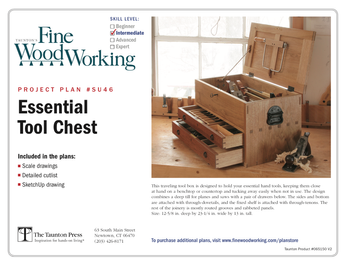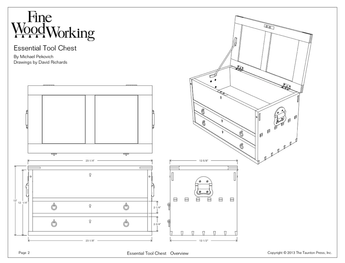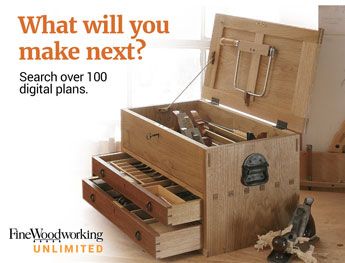Several of my projects required cross cutting larger panels. Between 18 and 24 inches wide. I am looking for a better way to cut these. I am thinking of adding a sliding table to my cabinet saw or buying a RAS. I like the Exactor because it can be installed on the left wing without having to remove it, leaving the full table available for other work. It is also easily be removed so save space when not in use.
<!—-><!—-> <!—->
The RAS seem like a good solution however, I used to have one and found it hard to keep square and rather dangerous for some cuts. I made several wooden bullets trying to dado small parts. The alignment problem was probably because it was a cheep homeowner version sold as do everything tool versus a good quality saw used exclusively for cross cutting. Reading many of the knots postings about RAS’s indicate that getting a good tool eliminates the alignment problem and they are unlikely to produce wooden bullets cross cutting longer stock. The RAS also takes up a lot of space in a small shop.
<!—-> <!—->
I have also considered a SCMS and using a table saw sled. The SCMS would not have enough depth and the sleds I have built work for smaller stock but seem cumbersome when working with longer stuff. Although I did read the article about the really big sled in FWW recently. Something like that one would probably work fine if I could build it accurately enough.
<!—-> <!—->
My question is about accuracy. Are the butter built RAS’s or the add-on sliding tables accurate enough for finish cuts. What are you guys (and gals) using who make a lot of say cabinet doors or other larger panels for cross cutting wider stock, how accurate is your solution and is it easy to use and make repeatable cuts?
<!—-> <!—->
Thanks for your help,
Bob T.
Edited 7/7/2009 3:00 pm ET by Y1RET















Replies
A table saw sled is good for cutting panels, and not too hard to make.
One can also make a rough cut with a circular, jig, of hand saw and clean up/square the line with a shooting board or an electric router guided by a straight edge.
Yes, commercial radial arm saws ARE much more accurate and stable than hobby/DIY ones. Try looking for a good quality machine such as that madse by The Original Saw Co, Italian makes such as Stromab and Maggi the British-made Wadkin BRA (similar in appearance to the first mentioned). You may need to replace the berings and guide bars, but as they are only hardened round rod it shouldn't cot too much
I use a shop made crosscut sled that rides in both miter slots. With the wider panels I may have to lower the blade below the table, then raise it up thru the panel to start.
mike
I have a JessEm mast-r-slide, it will do a 36" crosscut with ease and is very accurate. It's spendy, I'll give you that, but IMO its worth it.
I have a JessEm mast-r-slide.. I do also..
BUT it NEEDS a support for the off-hang on longer sticks. I use a pointed up 'V" cut on a stand that is level with the saw.... As in '/' for the off-hang to slide on.. Rollers DO NOT WORK as well! They tend to move the stick some way you do not make it want to move! My 'V' is a sanded off length or cold rolled steel that is flat! Now to get the stands that hold the steel level with the saw!
you do not make it want to move! Or was that rollers make the stick move off 90 to the blade? Not sure.
Edited 7/8/2009 12:26 pm by WillGeorge
Recently, I had to trim the ends of that little Shaker end table's top. Top was to be 22" x 22". I put the miter gauge in it's slot "Backwards" and used it to guide the cut about halfway through. I then shut off the saw and place the miter gauge in it's slot the "normal" way and finished the cut. I left the blade IN the kerf while doing this ( WITH THE SAW OFF!), then "backed off" just a hair and started the saw. Cut came out nice and straight. Remember, let the blade come to a FULL stop BEFORE switching the miter gauge's position.
I hear you .. And I have a TS slead with the 'true end' in front. and nothing in the back!
I also have a Jessem sliding table. The small size and smooth travel are great. It is excellent for large doors. I squared up four 22" wide by 40" tall pantry doors with ease. Well worth the money (after getting Jessem to send me a new top slide unit that wasn't so concave I could slide a nickle under the straight edge on it across the 6"- 8" width!). That took 3 months. Most Jessem products are top notch, but that little altercation didn't make me think much of their customer service. Rockler was very helpful in finally getting the replacement slider. Thumbs up to Rockler's customer service.
Mostly, I've used a table saw sled. More often I use my Festool t55 these days. The festool gives a chip free cut on both surfaces, whereas the sled doesn't always. I've also got the jessem slider attachment... its OK but watch out for tearout on the bottom face and its no good at all for small stock. I'm going to trade my table saw up for a slider style w/ scoring blade, I find as I age, my patience with fussing with half-baked solutions seems to ebb.
"I'm going to trade my table saw up for a slider style w/ scoring blade, I find as I age, my patience with fussing with half-baked solutions seems to ebb."
True for me also. By the time I end up futzing, I could have done 1 or 2 other operations.BB
I have a Festool saw and feel it is great for sawing up plywood. Festool is accurate and will not sprinter. Also it makes a fine 45 degree cut. Expensive but more flexible for many woodworking projects.
I use a sled, and recommend learning how to make and adjust one before buying something. It couldn't hurt.
Brian
I used a sled for years and had great success, but am learning to love the sliding table on my brandy new Jet Supersaw.
A sliding table attachment (mine does 49") or the festool system. Mine can easily support a full sheet... but I like the idea of the festool. Their saw and guide rail look like they are a lot easier to move.
better pics
That is a Nissan,is it not?
Yes, 350z Roadster (I have no kids).
"The RAS also takes up a lot of space in a small shop"
Well yes and no. A RAS or SCMS can be arranged down one wall with a support table either side, but that support table can also form a workbench with storage beneath. On the other hand using a crosscut sled/sliding carraige on the table saw takes up the full width of the table saw plus the length of the uncut panel times about three or four times the actual width of the panel. Draw it out and you'll see what I maen. The RAS has one major advantage over the SCMS - it will cut housings (dados) full width and consistent depth in a number of passes whereas every SCMS I've evr tried is a lot less consistent in depth of cut. The other suggestion made is the Festool saw and guide rail. That I can agree with for portability and space-saving, although there are other alternatives to the Festool system including saws/rails by Mafell (MT55cc), Makita (SP6000), deWalt (DWS520) and Hilti (WSC 255-KE/WSC 265-KE).
As with most things, the so-called "best" solution depends on several factors, it seems to me:
1. how much money one has to throw at the problem,
2. how much space is required to house and use the solution, and
3. how often one needs to perform the particular task.
How sexy the solution is also plays a role, but should probably NOT be part of a rational analysis. ;-)
Sliding table saws (or, auxiliary sliding attachments) seem to be an excellent solution for making moderately-wide crosscuts . . . for those with sufficient shop space and budget.
Radial arm saws aren't designed for cutting sheet goods, so to get much beyond a 12" (or so) cross cut capacity, you're really looking at one of the monster RAS models. For example, Delta's 10" "Pro" RAS will only do crosscuts up to about 16". The monster 18" (5hp, 240v) model comes close to 30". That's probably a little too intimidating for the average home shop, however.
SCMSs aren't designed for wide cuts, either, and get awfully "spindly" at full extension.
The new track saws look great, but the accuracy of the cut depends on the accuracy of placement (and clamping) of the guide rail. And, to be honest, one could achieve similar accuracy with a conventional circular saw with the addition of a good guide-rail setup and some added attention to the alignment of the saw's base.
Crosscut sleds take advantage of the tuning already done on the table saw, and are pretty economical to build. Additional in-feed and out-feed support is required, though, which obviously consumes shop space during use.
I use a router jigsaw and clamp with the assitance of a good square. I just used this to cut my top for my hutch. I use a strait edge to mark the line square and cut close with a good jigsaw. I then use that same good square to attach my grip tight clamp across. I have a good 50" and 24" for this purpose. I place it back the distance from the edge of my router base to the down spiral bit and run it across not taking too much at a time. Further, I make sure I clamp a sacrificial piece on the exit point so I don't blow it out. Works well, and provides a good smoth edge.
The nine most terrifying words in the English language are, 'I'm from the government and I'm here to help.' - Renaldus Magnus
It depends on how long your pieces are that you need to cross cut. I have several 22 inch wide boards that are 10 feet long.. no sled ever made will handle those safely. So I'm forced to either partially cut them on my sliding compound miter saw (which is extremely accurite) flip them over and cut the remainder,
Or use a straight edge and my skilsaw. While my skilsaw can handle boards up to 12 inches wide that's the limit without flipping. If I use the skilsaw I make double sure that I use the 4-5-6 rule and double check it. I used to use a framing square but found out that's almost 3/8ths of a degree off
Well, you said 'panels' 18" to 24" wide, so I assume that the length of your panels isn't much more than 33 - 34".
The answer from my perspective is that it depends on a couple of things.
John White has a cool, short video on FWW that shows how to control a partial sheet of plywood (aka a 'panel') using just the table saw at hand, it's guide fence, and a bar clamp. It assumes that the cut that you want to make is already parallel to the edge pressed against the guide. When that's true, you can't beat his method for speed, simplicity, and after a practice cut or two, accuracy.
If it is essential that the cut that I'm making be at exactly 90 degrees to the sides of the panel, then I use a large sled that I built specifically for that purpose. I can cut panels up to 25" wide on the one that I made. It requires that I set up an infeed table using my workbench (previously brought to the exact height of my table saw for that specific purpose - frankly a PITA but eventually worth the effort), and a side support that is also at the exact height of my table saw's table to support the slide as it slides - it must also be set up parallel to the table saws top to avoid the occasional, annoying tilt as I feed the panel though the setup. I built an outfeed table for the saw about the first day that I had it, so that's sort of a given.
One thing that I've discovered about large sleds is that mine seem to move "jes a little" with the seasons. "jes a little" is too much. This required me to remove the screwed and GLUED stop and attach a new one that I could adjust from time to time to make it actually 90 degrees to the blade on the day that I'm using it. The wooden one was replaced by a 1" by 4" by 35" length of aluminum extrusion that doesn't bow "jes a little", too.
My son recently was given a DeWalt (I think) version of the Festool with a 108" guide/slide. It cuts like a dream. It is also a little fussy to get it set up exactly 90 degrees to a panel's sides, but it's possible, and we do. Even with the fussiness, it takes a lot less time to set up than my table saw - work bench - side table - large sled setup does. We set it up on a folding cafeteria-style table with a 4'x8' sheet of 2" thick blue foam insulation. no muss, no fuss, depth of cut set for cleanest cut. It frankly isn't as 'elegant' as my custom made large slide, which looks cool, especially with it's coat of shellac. None the less, when he's around to loan me his new toy, that's what I now use.
Mike
Edited 7/18/2009 3:40 pm ET by Mike_D
Y1RET (does that mean you are RETired...)
I use a Festool 55 for panels and such. I have recently built my bath vanity 9' long with 5 boxes of Melamine and am doing a built in closet with 11 sheets of melamine MDF for the Ms.
For quick set up, I made a prototype jig for the 55, it has a groove to snap onto the festool guide rail. Important not be to large and interfere with the saw motor as it passes by. It looks fragile, and I will make a maple detail later. Plywood is a bit fragile if you drop it..
The board that is screwed to the jig, has two screws on the inside that can be adjusted to get it set up square. Very accurate, 1/64" over a 24" panel. Quick, easy, and accurate with no tear out with a the 55. Expensive... but it really shines.
View Image
Bottom of jig showing the cut groove to hold the festool rail. Two passes on the TS to get the correct width.
View Image
The clamp on the opposite end. Just a scrap with a hole at the edge and a typical t track bolt and knob. A large washer applies pressure to the scrap and the project piece. Use a scap of whatever you are cutting so the thickness is the same.
View Image
Hope this Helps
AZMO
-----------_o
---------_'-,>
-------(*)/ (*) http://www.EarthArtLandscape.com
What a great accessory for the track - way cool.
Thanks,
Mike
I use this mostly,the delta sliding table,very accurate a bit finicky to set up but once its done smooth sailing.
Dan
Sweet Setup!The nine most terrifying words in the English language are, 'I'm from the government and I'm here to help.' - Renaldus Magnus
Thanks Bones,I like it a lot the saw is solid as a rock with its cast iron base ,and I put the 31/2hp delta unisaw motor plus brand new trunnion,and arbor.as My friend would say- she's all new under the hood, its not My RT31 but its a very reliable second.
Torture Dan, (its what you tshirt shezz)
How wide of piece can you cut off on the sliding table? I can't really tell how far forward the table moves. If you were cutting a 8' long plywood piece that was 24" wide would it work for that?
Nice setup and I will bet it is easy to use.
Thanks Morgan <!----><!----><!---->
-----------_o
---------_'-,>
-------(*)/ (*) http://www.EarthArtLandscape.com
this slider is good for 32" but 36" works if you raise the blade into the piece,so yes it would work for that.as well you can remove the fence on the sliding table and use the table saw fence to cut sheets in half and such, there is a handle that pulls out under the top about 3'that is for cutting large sheet goods.I prefer the uni-fence for this because I can slide the fence back offering more support behind the cut and the piece is free after the cut.Dan
For sure, one of the main conciderations is how often you need this feature. Over twenty years ago I added an Excalibur sliding table to my Unisaw. I could not live without this add-on!!!It has a 48" travel and cuts 30" in front of the blade with the miter fence at the front. Placing the miter fence at the back allows the cutting of a 48" panel. Despite having this machine, I sometimes need to cut a 5' x 10' x 1" sheet. Way too heavy to move so I place some spacers on the floor and use my skill saw with a flip-straight edge. This is a straight edge with a spacer hinged to it. The spacer is equal to the distance from the side of the skill saw blade to the side of the saw's base. You line this up with your marks,clamp in place, flip the spacer out of the way and cut. Very economical and very easy to use. A sharp blade and proper saw blade depth give a cut equal to any table saw.
I agree with you on the excalibur. I had mine before I purchased my SawStop ICS. I tried to live without the slider. In fact, I made it about 3 or 4 months... but I couldn't live without it.
In the end, I wacked off the rail, removed the left extension wing and bolted the baby on. I couldn't be happier.
This forum post is now archived. Commenting has been disabled